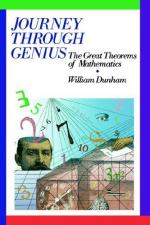
|
| Name: _________________________ | Period: ___________________ |
This test consists of 15 multiple choice questions and 5 short answer questions.
Multiple Choice Questions
1. What did George Cantor discover?
(a) A way to determine the accuracy of a calculation.
(b) A method to measure infinity.
(c) A way to compare the relative sizes of infinite sets.
(d) A method to measure a curved area.
2. Who were Johann and Jakob Bernoulli?
(a) Cousins and students with Newton at Cambridge.
(b) Brothers and students of Leibniz.
(c) Cousins and students with Leibniz in Paris.
(d) Twin brothers and students of Newton.
3. Where did George Cantor live in the 1860s and 1870s?
(a) Russia.
(b) Germany.
(c) Britian.
(d) Scotland.
4. Which phrase best describes Newton as a student at Cambridge?
(a) Unnoticed, but remarkable.
(b) Tolerant, mildly interested in science.
(c) Quiet recluse of no intelligence.
(d) A highly praised genius.
5. Where was Euler born?
(a) Switzerland.
(b) Finland.
(c) Denmark.
(d) Germany.
6. What is one proof that Euler was able to prove?
(a) Descartes' number theory.
(b) "little Fermat theorem."
(c) Bernoulli's principle of lift.
(d) Newton's method of calculus.
7. What did Cantor develop?
(a) A system to identify prime numbers of very large size.
(b) A method to factor very large composite numbers.
(c) A method to find the sum of a geometric series.
(d) A system to compare relative sizes of cardinal numbers.
8. Where did Newton go to school before he went to Cambridge?
(a) Cambridge Prep.
(b) Oxford Grammar School.
(c) Charles II Grammar School.
(d) The King's School.
9. Which name does NOT belong?
(a) Renee Descartes.
(b) Francois Viete
(c) Blaise Pascal.
(d) John Napier.
10. What is true about real numbers between 0 and 1?
(a) There is no set for these numbers.
(b) No sum can be determined.
(c) They are denumerable,
(d) They are not denumerable.
11. Who else, besides Newton, independently discovered a calculus method?
(a) Pierre de Fermat.
(b) John Napier.
(c) Gottfried Leibniz.
(d) Isaac Barrow.
12. What did George Cantor determine to be true of a set of rational numbers?
(a) They are non-denumerable.
(b) They are denumerable.
(c) They are all composite numbers.
(d) They are all prime numbers.
13. What did Newton's calculus involve?
(a) Determining the area under a curve.
(b) Proving the cubic equation.
(c) Proving the existance of pi.
(d) Determining the volume of a sphere.
14. What did Cantor's work do to mathematics?
(a) It raised arguments on the origins of geometry.
(b) It caused much agreement among mathematicians on the use of calculus.
(c) It forced the reexamination of set theory.
(d) It caused a reevaluation of basic algebra.
15. What did most of 19th century mathematics focus on, as highlighted by Dunham?
(a) Geometry.
(b) The theoretical.
(c) Algebra.
(d) The immediately practical.
Short Answer Questions
1. Which word best describes Newton's childhood?
2. Who encourages Newton during his studies at Cambridge?
3. What series was Euler most famous for?
4. Where did Euler study at the age of 20?
5. What hindered Euler's work as he grew older?
|
This section contains 456 words (approx. 2 pages at 300 words per page) |

|




